中南财经政法大学:《金融计量学》课程教学课件(双语讲稿)Chapter 04 Causal Inference framework 2
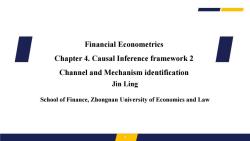
Financial Econometrics Chapter 4.Causal Inference framework 2 Channel and Mechanism identification Jin Ling School of Finance,Zhongnan University of Economics and Law
Financial Econometrics Chapter 4. Causal Inference framework 2 Channel and Mechanism identification Jin Ling School of Finance, Zhongnan University of Economics and Law 1
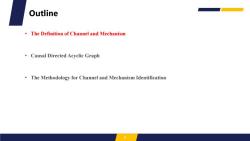
Outline The Definition of Channel and Mechanism Causal Directed Acyclic Graph The Methodology for Channel and Mechanism Identification 2
• The Definition of Channel and Mechanism • Causal Directed Acyclic Graph • The Methodology for Channel and Mechanism Identification 2 Outline

The Definition of Channel and Mechanism ·The definition: Channel and mechanism depict how treatment leads to changes of outcome variables. ·作用渠道或作用机制刻画因果效应何以存在、如何存在。 Managers'education and corporate operation;Bank competition and financial constraints;Retail investors trading and market stability. Why the identification of channel or mechanism is important? Convince us that the Causal effect does not originate from coincidence. To verify the financial theories. Further applications. 3
• The definition: • Channel and mechanism depict how treatment leads to changes of outcome variables. • 作用渠道或作用机制刻画因果效应何以存在、如何存在。 • Managers' education and corporate operation; Bank competition and financial constraints; Retail investors trading and market stability. • Why the identification of channel or mechanism is important? • Convince us that the Causal effect does not originate from coincidence. • To verify the financial theories. • Further applications. 3 The Definition of Channel and Mechanism

The Definition of Channel and Mechanism The key of Rubin Causal Model: ·Treatment-→Dutcomes. The treatment and non-treatment outcomes under same condition(assignment mechanism). Counterfactual outcomes. ·What will disturb unconfoundedness(非混杂性)? (Yo,Yu)IL D:Xi Covariates. D (a)基本因果模型I (b)基本因果模型Ⅱ (e)基本因果模型Ⅲ
• The key of Rubin Causal Model: • Treatment→Outcomes. • The treatment and non-treatment outcomes under same condition (assignment mechanism). • Counterfactual outcomes. • What will disturb unconfoundedness (非混杂性)? • Covariates. 4 The Definition of Channel and Mechanism

The Definition of Channel and Mechanism The correlation and causal effect: Causal inference:Causal identification and statistical inference. Causal identification:if A is not correlated with B,there is no causal effect between A and B.If A is corelated with B and there is only a causal model to identify the correlation,A leads to B or B leads to A. Statistical inference:Significant or insignificant correlation. If the coefficient for variable A in a regression on B is insignificant,can we conclude A has no causal effect on B? If the coefficient for variable A in a regression on B is significant,can we conclude A has a causal effect on B?
• The correlation and causal effect: • Causal inference: Causal identification and statistical inference. • Causal identification: if A is not correlated with B, there is no causal effect between A and B. If A is corelated with B and there is only a causal model to identify the correlation, A leads to B or B leads to A. • Statistical inference: Significant or insignificant correlation. • If the coefficient for variable A in a regression on B is insignificant, can we conclude A has no causal effect on B? • If the coefficient for variable A in a regression on B is significant, can we conclude A has a causal effect on B? 5 The Definition of Channel and Mechanism

The Definition of Channel and Mechanism The purpose of causal inference: The relationship between financial variables. The foundation:Financial theories. To understand Causal effect.The financial theory determines the Causal effect. Exploring the channel and mechanism can help ensure unconfoundedness. Why?If the Causal effect originates from the differences in unobservable covariates,what will happen when we explore the channel and mechanism? Consumer coupon and consumer spending. 6
• The purpose of causal inference: • The relationship between financial variables. • The foundation: Financial theories. • To understand Causal effect. The financial theory determines the Causal effect. • Exploring the channel and mechanism can help ensure unconfoundedness. • Why? If the Causal effect originates from the differences in unobservable covariates, what will happen when we explore the channel and mechanism? • Consumer coupon and consumer spending. 6 The Definition of Channel and Mechanism
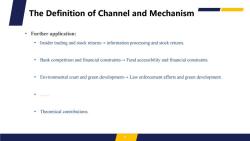
The Definition of Channel and Mechanism Further application: Insider trading and stock returns-information processing and stock returns. Bank competition and financial constraints-Fund accessibility and financial constraints. Environmental court and green development-Law enforcement efforts and green development. Theoretical contributions
• Further application: • Insider trading and stock returns→ information processing and stock returns. • Bank competition and financial constraints→ Fund accessibility and financial constraints. • Environmental court and green development→ Law enforcement efforts and green development. • . • Theoretical contributions. 7 The Definition of Channel and Mechanism
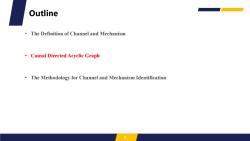
Outline The Definition of Channel and Mechanism Causal Directed Acyclic Graph The Methodology for Channel and Mechanism Identification 8
• The Definition of Channel and Mechanism • Causal Directed Acyclic Graph • The Methodology for Channel and Mechanism Identification 8 Outline
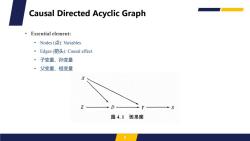
Causal Directed Acyclic Graph 。 Essential element: ·Nodes(点):Variables ·Edges(箭头):Causal effect. ·子变量、孙变量 ·父变量、祖变量 图4.1因果图 9
• Essential element: • Nodes (点): Variables. • Edges (箭头): Causal effect. • 子变量、孙变量 • 父变量、祖变量 9 Causal Directed Acyclic Graph
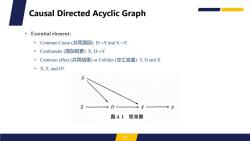
Causal Directed Acyclic Graph 。Essential element: ·Common Cause(共同原因):D→/and X→Y. ·Confounder(混杂因素):X,D→Y ·Common effect(共同结果)or Collider(交汇变量):Y,D and X. ·,X,Z,andD? Z D 图4.1因果图 10
• Essential element: • Common Cause (共同原因): D→Y and X→Y. • Confounder (混杂因素): X, D→Y. • Common effect (共同结果) or Collider (交汇变量): Y, D and X. • X, Z, and D? 10 Causal Directed Acyclic Graph
按次数下载不扣除下载券;
注册用户24小时内重复下载只扣除一次;
顺序:VIP每日次数-->可用次数-->下载券;
- 中南财经政法大学:《金融计量学》课程教学课件(双语讲稿)Chapter 03 Causal Inference framework 1.pdf
- 中南财经政法大学:《金融计量学》课程教学课件(双语讲稿)Chapter 02 Statistical Foundations Overview of OLS.pdf
- 中南财经政法大学:《金融计量学》课程教学课件(双语讲稿)Chapter 14 Application Financial Market.pdf
- 中南财经政法大学:《金融计量学》课程教学课件(双语讲稿)Chapter 13 Application Corporate Finance.pdf
- 中南财经政法大学:《金融计量学》课程教学课件(双语讲稿)Chapter 12 Application Policy Evaluation.pdf
- 中南财经政法大学:《金融计量学》课程教学课件(双语讲稿)Chapter 11 Regression Discontinuity Design.pdf
- 中南财经政法大学:《金融计量学》课程教学课件(双语讲稿)Chapter 10 Propensity Score Matching.pdf
- 中南财经政法大学:《金融计量学》课程教学课件(双语讲稿)Chapter 01 Introduction to Financial Econometrics.pdf
- 中南财经政法大学:《中级计量经济学》课程教学课件(PPT讲稿)week 13 限值因变量模型和样本选择纠正.pptx
- 中南财经政法大学:《中级计量经济学》课程教学课件(PPT讲稿)week 11 高深的面板数据.pptx
- 中南财经政法大学:《中级计量经济学》课程教学课件(PPT讲稿)week 10 独立混合横截面数据.pptx
- 《中级计量经济学》课程教学资源(书籍文献)James H. Stock, Mark W. Watson - Introduction to Econometrics, Global Edition-Pearson Education Limited(2020).pdf
- 《中级计量经济学》课程教学资源(书籍文献)工具变量IV - IV paper-Acemoglu-ColonialOriginsComparative-2001.pdf
- 中南财经政法大学:《中级计量经济学》课程教学课件(PPT讲稿)week 9 工具变量估计与两阶段最小二乘法.pptx
- 中南财经政法大学:《中级计量经济学》课程教学课件(PPT讲稿)week 8 模型设定误差和数据问题.pptx
- 中南财经政法大学:《中级计量经济学》课程教学课件(PPT讲稿)week 6 异方差性(主讲:刘玲).pptx
- 中南财经政法大学:《中级计量经济学》课程教学课件(PPT讲稿)week 5 多元回归分析-深入专题.pptx
- 中南财经政法大学:《中级计量经济学》课程教学课件(PPT讲稿)week 4 多元回归分析-推断.pptx
- 中南财经政法大学:《中级计量经济学》课程教学课件(PPT讲稿)week 3 多元回归分析-估计.pptx
- 中南财经政法大学:《中级计量经济学》课程教学课件(PPT讲稿)week 2 简单回归模型.pptx
- 中南财经政法大学:《金融计量学》课程教学课件(双语讲稿)Chapter 05 Mediation Effect and Moderating Effect.pdf
- 中南财经政法大学:《金融计量学》课程教学课件(双语讲稿)Chapter 06 Control Variable and Fixed Effect.pdf
- 中南财经政法大学:《金融计量学》课程教学课件(双语讲稿)Chapter 07 Difference-in-difference Model 1.pdf
- 中南财经政法大学:《金融计量学》课程教学课件(双语讲稿)Chapter 08 Difference-in-difference Model 2.pdf
- 中南财经政法大学:《金融计量学》课程教学课件(双语讲稿)Chapter 09 Instrumental Variable Regression.pdf
- 《马克思主义政治经济学》课程教学课件(PPT讲稿)第一章 导论.ppt
- 《马克思主义政治经济学》课程教学课件(PPT讲稿)第七章 经济全球化与当代资本主义.ppt
- 《马克思主义政治经济学》课程教学课件(PPT讲稿)第三章 剩余价值理论.ppt
- 《马克思主义政治经济学》课程教学课件(PPT讲稿)第二章 马克思与劳动价值论.ppt
- 《马克思主义政治经济学》课程教学课件(PPT讲稿)第五章 资本社会化与资本主义所有制.ppt
- 《马克思主义政治经济学》课程教学课件(PPT讲稿)第八章 资本主义的未来.ppt
- 《马克思主义政治经济学》课程教学课件(PPT讲稿)第六讲 资本主义市场经济体制与资本主义经济的发展.ppt
- 《马克思主义政治经济学》课程教学课件(PPT讲稿)第四章 本积累和资本主义分配制度.ppt
- 重庆工商大学:《会计学》教学大纲 ACCOUNTING A.pdf
- 重庆工商大学:《会计学》课程授课教案(讲义).pdf
- 重庆工商大学:《会计学》课程教学实验指导书.doc
- 重庆工商大学:《会计学》课程教学课件(PPT讲稿)第一章 总论.ppt
- 重庆工商大学:《会计学》课程教学课件(PPT讲稿)第三章 主要经济业务的核算.ppt
- 重庆工商大学:《会计学》课程教学课件(PPT讲稿)第二章 复式记账法.pptx
- 重庆工商大学:《会计学》课程教学课件(PPT讲稿)第五章 信息化背景下的会计核算.pptx
